If tulips are not taken care of properly, you will see various illness signs, such as the browning of leaves. Browning can be categorized into two types, brown spots on leaves or brown tips.
But why are your tulips turning brown? Let’s find out.
Lack of water often leads to brown leaves in tulip plants. If you are not watering the plant correctly, start watering them adequately. Other possible problems include poor water quality, over-fertilization, improper lighting, poor air circulation, root rot, and pests infestations.
Avoid using poor draining soil and try to spray horticulture oil frequently to recover tulips from brown leaves.
There can be various problems your plant might be dealing with, and you have to treat them accordingly by identifying the actual causes.
This article will help you know why your tulips are turning brown and how to resolve this issue.
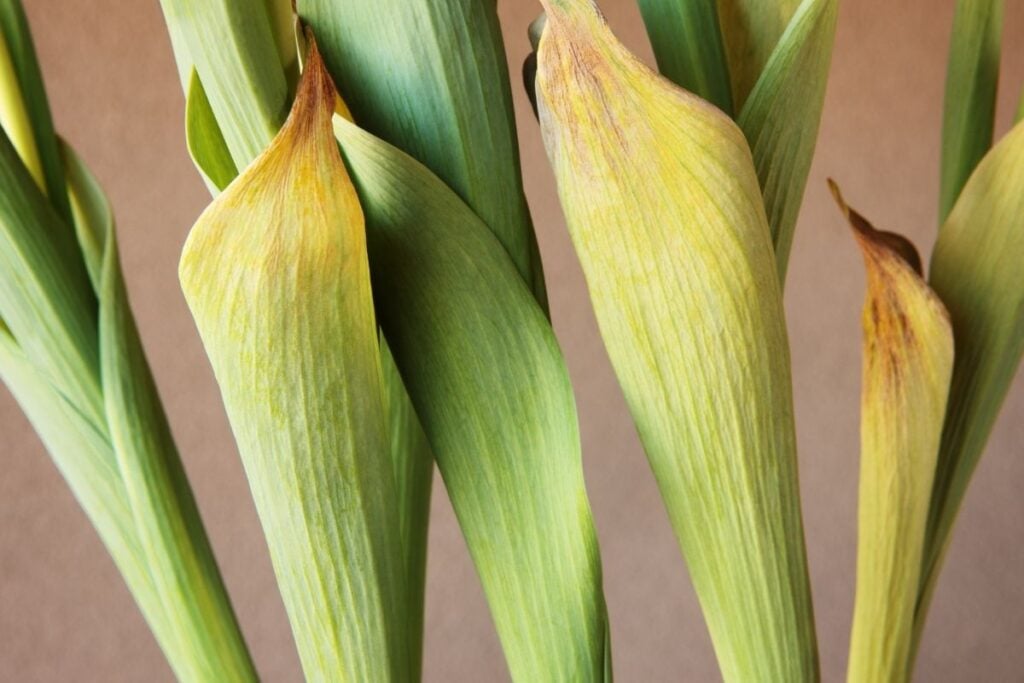
Identifying the browning in tulips
If tulips are experiencing any problem, they will try to show signs of illness.
If you notice any signs like brown spots or brown tips on leaves, it means that your tulips are suffering from severe problems, and you should immediately take action for their speedy recovery.
To identify the exact problem your plant might suffer from, and you should observe and look at your tulips closely. Try to find out why your plant is showing such symptoms and resolve this issue as soon as possible.
Let’s read further why the leaves of tulips are turning brown and how to solve the problem quickly.
Causes of brown leaves in Tulips
Various causes make it difficult for us to understand why tulips are turning brown. But with a bit of attention, we can find out the exact reason.
Now let’s look at all the possible causes.
- Improper watering
- Poor quality of water
- Overfertilization
- Insufficient lighting
- Poor air circulation
- Root rot
- Pests infestations
Let’s discuss the above points in detail.
Improper watering
Properly watering your tulips help to keep the sickness away. If the tulips do not get enough water, they will not be able to grow correctly.
Tulips enjoy good moisture in the soil to grow well, but they should not be soggy. Both overwatering and under watering can cause brown leaves on tulips. Let us discuss how.
Looking for gardening supplies? We have tested 100's of products before recommending them to you guys. Check out our best pick below:
| Image | Gardening Supplies | Best Price? |
|---|---|---|
 Top
Top Top
Top | Raised Garden Bed Kit | Check On Amazon |
 | XLUX Soil Moisture Meter, Plant Water Monitor, Soil Hygrometer Sensor for Gardening, Farming, Indoor and Outdoor Plants, No Batteries Required | No Results |
 Top
Top Top
Top | 82 Pcs Garden Tools Set and Extra Succulent Tools Set | Check On Amazon |
 | Joeys Garden Expandable Garden Hose with 8 Function Hose Nozzle, Lightweight Anti-Kink Flexible Garden Hoses, Extra Strength Fabric with Double Latex Core, (50 FT, Black) | No Results |
 Top
Top Top
Top | Dual Chamber Compost Tumbler | Check On Amazon |
 Top
Top Top
Top | Sunnyglade Plant Stakes | Check On Amazon |
 Top
Top Top
Top | Organic Cold Pressed Neem Seed Oil | Check On Amazon |
 Top
Top Top
Top | Mighty Mint Gallon :-Insect and Pest Control Peppermint Oil | Check On Amazon |
 Top
Top Top
Top | Scotts DiseaseEx Lawn Fungicide | Check On Amazon |
 Top
Top Top
Top | Jacks Classic 20-20-20 All Purpose Fertilizer | Check On Amazon |
 Top
Top Top
Top | 30,000 Seeds Pollinator Attracting Wildflower Mixture | Check On Amazon |
 Top
Top Top
Top | Survival Vegetable Seeds Garden Kit-Over 16,000 Seeds | Check On Amazon |
Overwatering
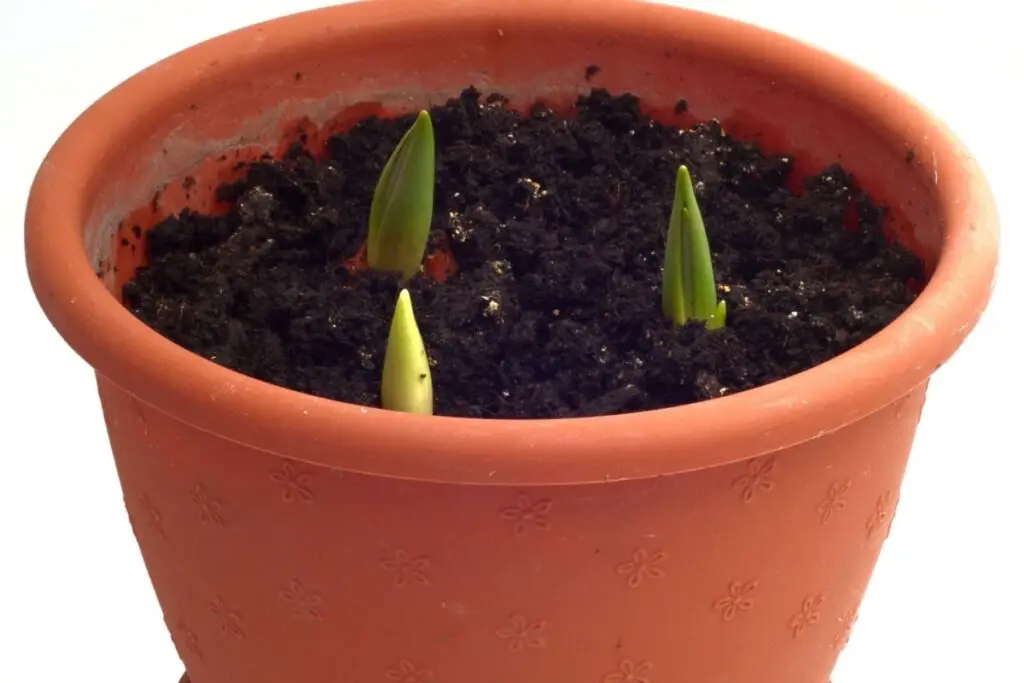
Overwatering can be the reason your tulips are turning brown. Tulips don’t like to stay in water for too long.
It happens primarily due to poorly draining soil. Due to this, the plant can suffer from overwatering frequently, which can cause root rot disease.
Outdoor plants don’t need to be watered regularly as frequent watering will directly damage the roots, and you will find various symptoms like brown spots or brown tips on leaves of tulips.
Watering your tulips once a week is enough for them to stay moisturized and grow properly. If you have overwatered your plant by any chance, you should immediately treat them as soon as possible to avoid root rot problems in the future.
Solution
Without getting stressed, you can protect the plant from getting overwatered quickly, and you just have to follow the steps given below:
- Check the soil’s moisture level before you water your tulips.
- You can check the moisture by applying the finger method. Place your index finger 1-2 inches deep inside the soil.
- If you observe the soil is wet, cold, and moist, it means the plant does not need to be watered.
- Keep checking it by using this method, and don’t water your tulips until and unless the soil is completely dry.
- Always watch out for the weather conditions. If the weather is humid, avoid watering during that time and try to provide as much as direct sunlight to dry up the soil.
- Make additional space between the roots by making a hole so that oxygen can reach inside the soil.
Also read: How To Save Overwatered Tulips? (Possible Signs, Causes & How To Fix)
Underwatering
Tulips are outdoor plants that thrive in excellent weather conditions with whole-day direct sunlight. They do not need water frequently until and unless it is hot, especially during the summer season.
If the weather is too hot for tulips and the sun is directly hitting them with harsh rays, they might suffer from the problem of underwatering.
Another reason your plant might suffer from underwatering is when you forgot to water your tulips for 2-3 weeks straight.
As the plant gets dehydrated due to less water present in the soil, the leaves of tulips eventually start to dry and turn brown.
Tulips should be watered sufficiently and should not stay dehydrated for a longer period. Due to dehydration, the plant fails to get enough water and minerals from the roots, making them completely weak.
Solution
You can solve this problem quickly by following the steps given below:
- If the soil is very dry, water your tulips regularly. Make sure you water them in little quantity and not too much.
- Avoid excessive heat conditions and provide your tulips with some shade so that the water will not evaporate quickly. But do this only when the weather is hot.
- When the plant is retrieved, stick to the proper watering schedule of tulips. And check the soil moisture before watering it.
Also read: How Often Do Tulips Need To Be Watered? (Tulip Watering Needs )
Poor quality of water
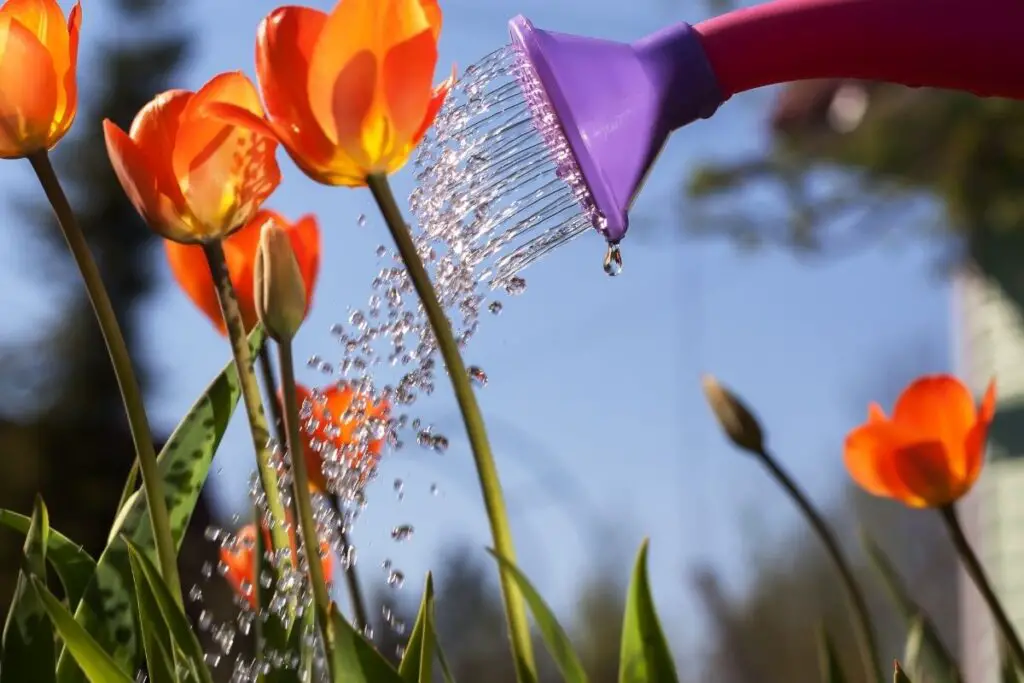
Poor quality of water can also cause brown leaves of tulips. Providing tap water to tulips can cause severe damage to the plants.
Tap water contains sodium and chloride in higher concentrations which can harm your tulips. Minerals are also present in the water, such as fluorine, chlorine, sulfur, and calcium, which your plant doesn’t need.
Due to such minerals, tulips fail to absorb water and nutrients from the roots and cause brown tips on tulip leaves.
Solution
- Avoid using tap water and use distilled water instead.
- You can use tap water only after purifying it. Boil tap water until it starts to vaporize to purify it.
- After that, wait till the water cools off. When the water gets at an average temperature, it’s ready for watering your tulips.
Overfertilization
Overfertilization is the most common problem your plant can suffer. Tulips only require small units of nutrients to grow well.
You should fertilize this plant once a year, and unlike other plants, tulips do not need to be fertilized frequently.
As fertilizer contains sodium chloride in a large amount, if the plant is over-fertilized, the salts absorb the water present in the soil, making it difficult for tulips to absorb water and nutrients from the roots.
Tulips show symptoms like brown tips on leaves due to the soil’s loss of water and nutrients.
Solution
Fertilize your tulips with a slow-release fertilizer in the N-P-K ratio of 10:10:10. Make sure you apply only a small amount of fertilizer.
For an overfertilized tulip:
- You can remove the excess fertilizer by scratching the top layer of the soil.
- If the situation is worse, transplant your tulips in a new location with fresh and suitable soil.
Also read: What Is The Best Fertilizer For Tulips? (Organic+Inorganic)
Insufficient light
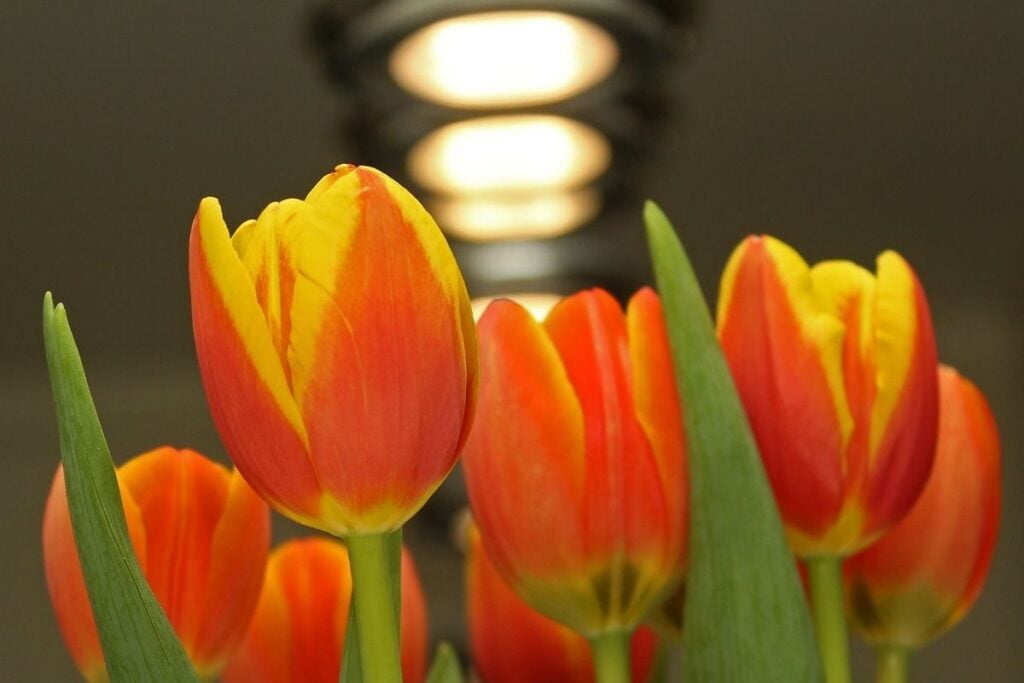
Tulips can get brown tips on leaves if they do not get proper sunlight. Tulips need at least 6 hours of direct sunlight every day to thrive.
If tulips do not get adequate sunlight, the process of photosynthesis will not take place properly. Due to which the plant will not be able to synthesize food, and because of lack of energy, tulips get weak and shows symptoms like brown leaves.
That is why lack of light directly affects the health of a plant and weakens the entire plant. You should try to provide direct sunlight to tulips as much as possible to avoid the browning of leaves.
Solution
- If your tulips are growing in a location where they are not getting enough light, you should transplant them into a new location. But be careful while transplanting them as it can cause stress to your plant.
- Make sure you choose a location where your tulips will get 6 hours of direct sunlight daily.
- If any obstacles are blocking the light, remove them.
Also read: How Much Sunlight Do Tulips Need? (Tulip Light Needs)
Poor air circulation
Poor air circulation into the soil can also cause brown leaves on tulips. The plant can be stressed due to bad air circulation among the roots.
It happens primarily because of poor soil. If the soil has a heavy texture, it will cause a problem for plants to breathe correctly. Good air circulation also keep fungus infections away from the plant and encourages the plant to grow healthy.
Try to provide good airflow into the soil to make sure that the plant is healthy and safe.
Solution
- Soil should contain enough amount of sand to provide air gaps into the roots.
- To improve the heavy texture of the soil, you can add organic matter and manure compost into the soil.
- If the soil is too tight, make small holes to provide airflow to the roots.
Root rot
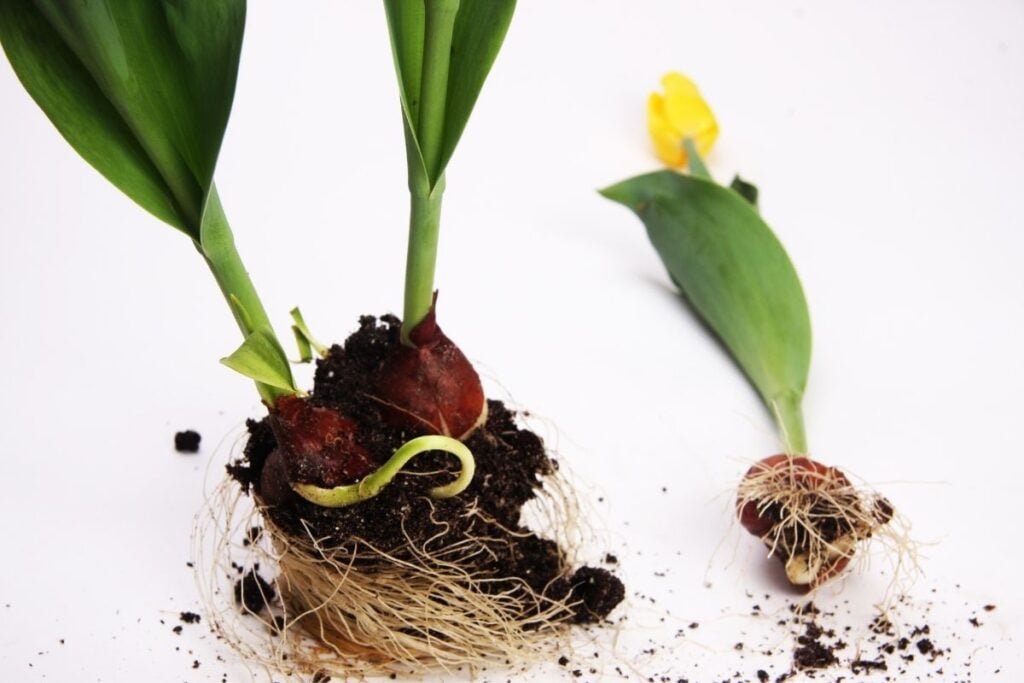
Root rot is mainly caused because of overwatering, poorly draining soil, and lack of sunlight.
If the water sits on the soil for a longer time, various kinds of fungi infections start to occur inside the soil and cause severe damage.
As various pathogens and fungi infestations develop in the roots, it becomes difficult to survive.
Because of root rot disease, the plant will not absorb nutrients which causes weakness to them, and they begin to show symptoms like brown tips on leaves.
Solution
- Water your tulips only when the soil is completely dry.
- Make sure you add enough sand content to the soil to improve drainage.
- Provide your plant with a whole day of direct sunlight to recover them.
- If the situation is out of control and the roots have been completely damaged, replant tulips in a new location by removing the injured roots.
- If you notice even one brown leaf, don’t water your plant for at least 3-4 weeks.
Also read: What Kind Of Soil Is Good For Tulips? (Best Soil Mix)
Pest infestations
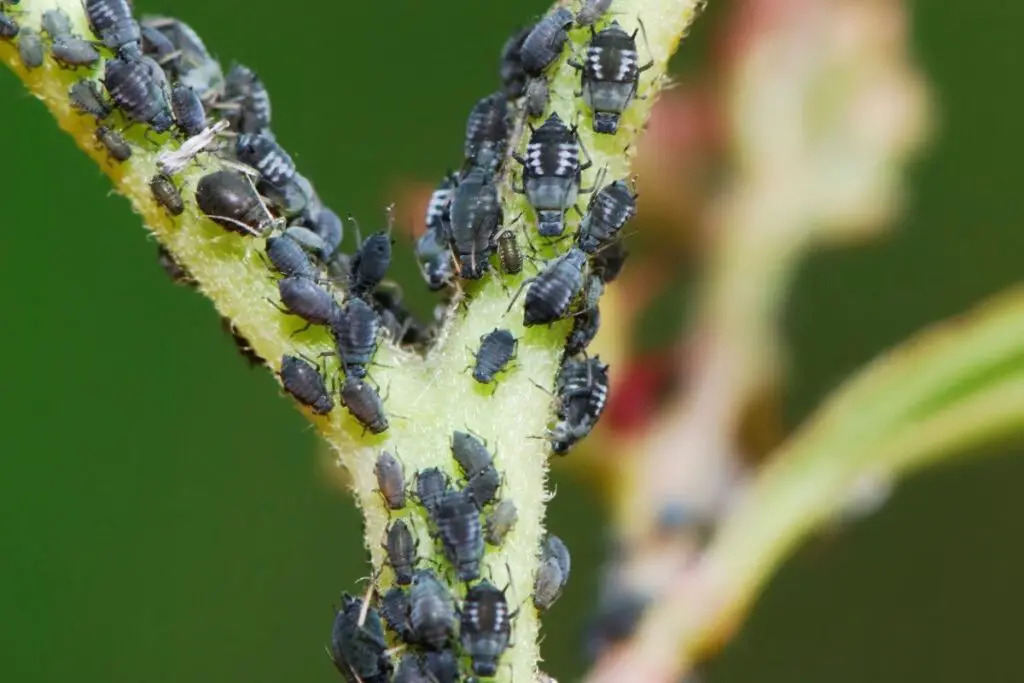
Pest infestations can also cause the browning of leaves on tulips. It happens because pests suck out the sap from the leaves and cause injury to the plant.
The common pests that possibly attack tulips are spider mites, bulb mites, aphids, larvae, and slugs.
When all these pests feed on the leaves, the area becomes mottled brown as the leaves lose all the nutrients making the plant completely weak.
If you notice any brown leaves on tulips, you should immediately check whether any pests have attacked your plant or not. If yes, treat them as soon as possible to avoid further issues.
Solution
- To get rid of all the pests, wash your tulips by using a shower pipe. But make sure you do it in a very gentle way without causing any injury.
- You can also wash them with a strong spray using insecticide soap or horticulture oil.
- After washing your tulips, sanitize the surrounding area so that the pests will not return.
- You can also use organic pesticides to get rid of them.
Also read: Bugs On Tulips: (Common Pests, Identification+How To Get Rid)
Finals words
You should identify the problem immediately to treat your tulips well. Once you find out the exact problem your plant is suffering from, it becomes easier to recover them.
Providing your tulips with adequate water and sunlight solves half of the problem. Pruning encourages the plant to grow well, so remove the already damaged leaves as they cannot recover.
Source: Wikipedia, North Dakota Stae University, The Royal Horticultural Society.
